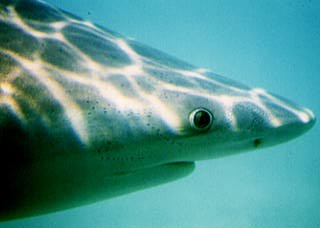
Overview
Introduction
to Sharks
Tagging and Migration
How Do Sharks Migrate?
What Factors Cause Shark Migration?
Shark Distribution
Migration Characteristics of Three Specific Sharks in the
Northern Atlantic Ocean
What Factors Affect the Success of Shark Migration?
and Water Temperature
What Does Tagging Have To Do With Migration?
Workbook
Activities
for Classroom
Shark Tagging Learning Activity
How Do Sharks Migrate? There are many unanswered questions as to how sharks and other animals know when and in what direction to migrate. How do animals know that there is more abundant food and water, more comfortable temperatures or more favorable breeding grounds located hundreds or even thousands of miles away? Even more amazing, how do animals navigate over great distances when there are no permanent landmarks or maps to guide them? Researchers have proven that migratory animals such as birds or caribou use a wide variety of senses to navigate from one point to another. The most obvious are physical and visual cues, such as following river beds, coastlines or mountain ranges from the ground or the air. Birds, some fish, and turtles also navigate by following the sun, by light waves reflecting off water, by responding to the earth's magnetic fields and even by the stars at night. Sharks navigate mainly by electro-reception and a sensitivity to pressure and water temperature. Located at the front of a shark's head is an extremely sensitive system of bio-electrical sensors which we believe helps them to navigate in response to the ocean's currents and the earth's electro-magnetic field. One part of this system, the ampullae of Lorenzini, consists of jelly filled pores with external openings large enough to be seen by the naked eye. These pores detect faint electrical currents given off by the earth's magnetic field -- or by other living creatures. The pores seem to function like an internal compass, helping sharks to orient themselves in relation to north-south (the strongest electro-magnetic fields) and east-west (weaker) electrical fields. The shark's lateral line system helps it to have a sensitivity to pressure. The lateral line, made up of fluid-filled sensory canals and tiny hair-like receptors, is sensitive to changes in pressure, vibration, movement and sound. It also helps sharks to orient themselves for direction and migration purposes. Together, the bio-electrical and lateral line sensors allow the shark to navigate, silent and unseen, beneath the surface of the ocean.
 In addition to aiding the shark in navigation, the ampullae of Lorenzini and the
lateral line system are particularly important in helping a shark detect the
presence of prey. This system is so sensitive that great white sharks are able
to detect a mammal heartbeat from a distance of 9 feet, just by responding to
electrical currents in the water.
In addition to aiding the shark in navigation, the ampullae of Lorenzini and the
lateral line system are particularly important in helping a shark detect the
presence of prey. This system is so sensitive that great white sharks are able
to detect a mammal heartbeat from a distance of 9 feet, just by responding to
electrical currents in the water.
Copyright © Ocean Of Know